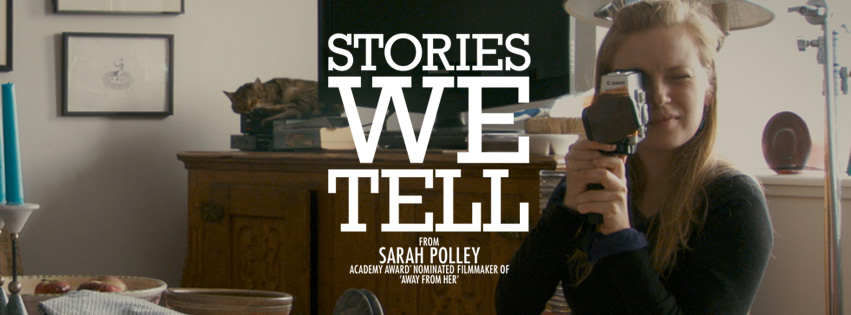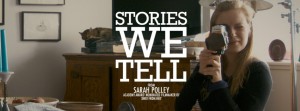The following text was written and presented by Roberta Mock, to introduce the screening of Stories We Tell on 22 February 2016 as part of the Peninsula Arts Women & Cinema season.
Our film tonight, Stories We Tell, was made by Sarah Polley, who is an actor, writer and director from Toronto. She started performing as a child, and was in her first Disney film at the age of four. In 1997, at the age of 18, she featured in Atom Egoyan’s film, The Sweet Hereafter, which brought her to the attention of arthouse audiences. Her first full length film as a director was Away from Her, starring Julie Christie, in 2006. She has continued to act alongside directing, appearing in the 2004 Dawn of the Dead reboot as well as the 2009 Canadian-French sci-fi horror, Splice.
We’re watching this film together tonight because about a year ago I was having lunch at my uncle’s house in Toronto and we were talking about movies. I was particularly interested in knowing what recent Canadian films my family would recommend – they tend to have very good taste. And, although this is not necessarily connected, several – including my uncle and my cousin, Jeremy – have worked in the Canadian film industry for a long time.
I’m telling you this for a reason. For as long as I can remember, I have told stories about my family – and, to be more specific, this side of my family: my mother’s mother’s. I felt and continue to feel very close to them, although we never lived in the same city and rarely saw each other.
When I was 17, I ran into Jeremy’s brother Stephen at Harbourfront in Toronto. I hadn’t seen him in well over a year and the first thing he did was to ask me whether I had seen the new Peter Greenaway movie. I found this incredibly glamorous in a slightly strange way. Jeremy’s and Stephen’s father, my great uncle Sid, was like a kindly god-figure to me. Among his other remarkable achievements, he was the first person in Canada to experiment with LSD, one of the first batches being used in experimental psychiatry at the time, and write about it in the popular press.
My point is that I now realize that I was telling stories about my family as a way of positioning and constructing my own sense of identity. In fact, from this distance, it looks like an act of vicarious self-mythologisation. What my family did before I was born had very little to do with me. But how I told people about what they did actually has everything to do with me. Storytelling is a performance – that is, a communicative event bounded by considerations of space and time – but it is also what may be described as ‘performative’.
The concept of performativity arises from speech act theory and one of its key texts is J.L. Austin’s How to do Things with Words. This is a collection of talks he gave in the mid 1950s, but published after his death in 1962. The main thing about the ‘performative utterance’ is that it does more than simply describe or point to something: it ‘performs it’, makes it so. And so, we might consider the act of storytelling as performative, as it produces the speaking subject, the self, rather than representing it.
Stories We Tell by Sarah Polley is an act of self-construction. It is the fact that she tells the stories of her parents (or allows them to be told) and the way she tells them that are significant here. Something that is important about performatives is that they are neither true nor false; they simply are.
Performatives are discursive acts that create something in a shared space. It is no coincidence that Polley seamlessly merges personal home movie footage with ‘fake’ footage that she’s recreated artistically with actors, made to look period. For many people, it is hard to tell at first (or maybe even more than at first) what’s ‘real’ and what isn’t.
I would suggest that it doesn’t matter – or rather, it matters very much that both types of footage are authentic in terms of their positioning in a film about self-construction. And something that is equally important is the fact that the Sarah Polley we see on screen, according to my cousin, is a persona created for the purposes of telling this particular story, in this particular way.
A few months ago, I took part in a professional development workshop, run by the performance artist, Marcia Farquhar, that focused on storytelling. In fact, on Wednesday (24 February 2016), the Live Art Development Agency in London is premiering a new film called And I by Reynir Hutber in which Marcia speaks for 8 hours, her monologue only prompted and interrupted occasionally by the film-maker. In the promotional blurb, Marcia is described as a “many-storied artist and notorious orator”. Marcia has told me several times that she is not interested in veracity which, she says, should never stand in the way of a good story. It is the storying that needs to make sense, not its historical narrative.
In psychoanalytic theory the process of narrativisation enables a sense of subject agency by externalising a traumatic memory. Central to this is the role of the ‘confirming witness’. I am not implying that all storytelling is therapeutic or necessarily the result of, or a response to, trauma.
However, it does point to the importance of the witness or listener to the creative practice of narrativisation. It is the structure of exchange and intersubjectivity that enables the narrative itself to be constructed. As Dee Heddon writes in her book Autobiography and Performance, “we are all equally invested in the dialogic relationship between address-ability and response-ability; the very process of subjectivity itself engenders each of us as necessary witness.”
Along with perhaps thinking about our own senses of being addressed and responding to Stories We Tell, I think it is worth also considering one of the functions of autobiographical narratives as provoking reflection on our own lives. This is a film that makes us think about what a family is – nurture and nature, them that birthed you and them that raised you – and what your parents’ past might mean to your own sense of presence and being present.
Cousin Jeremy is a self-confessed “big Polley fan”. He says she “seems to have her head screwed on right, she never got sucked into the star machinery, is vocal about liberal political causes she believes in and has made time to have two children in the past few years.” I can’t help but wonder about her own sense of the maternal in relation to her art-making as she reflected on her mother’s.
Jeremy knew Polley when she was 8 years old. At the time he was running publicity at Atlantis Films in Toronto and she was starring as Ramona in the TV series adaptation of Beverly Cleary’s Ramona books. I loved those books myself. Jeremy remembers Sarah as precocious and articulate. He told me that he once set up an interview between Sarah and the TV beat reporter for the Toronto Sun newspaper. After it, and looking dazed, the reporter came up to him and said, “Please tell me that’s not a midget impersonating a little girl.”
I realize this is gossip and I have no problem with embracing it. Gossip is another form of self-narrativisation. Irit Rogoff has written that, although it is often ostensibly about something that has already happened, gossip is a form of testimony that is “invariably located in the present.” It externalizes and makes “overt its relations to subjectivity, voyeuristic pleasure and the communicative circularity of story-telling.”
Cousin Jeremy has made me promise that I will not spoil the mystery at the heart of the film for you. But it is hardly giving too much away to say that the narrative revolves around who Polley’s “real” father is and that there are a number of options available.
One of the potential fathers (although not long in the running) is an actor named Wayne Robson, a small, wiry guy who played character roles. Jeremy says he had a kind of scrunchy, mobile leprechaun face so that even at 35 he could play 75 year-old men. And Wayne, who is now deceased, was a very close friend of Jeremy’s late brother, my cousin Stephen. In fact, Stephen was godfather to Wayne’s daughter, Ivy.
Perhaps this is simply a small story about the smallness of the Canadian film industry. Perhaps it is a story that Jeremy told me as a way of telling me something about himself. And perhaps it is a story I have told to you so you understand something, faintly, beneath the surface, about me.
Enjoy the film.

About the Author:
Roberta Mock is Professor of Performance Studies and Director of The Arts Institute at Plymouth University.


